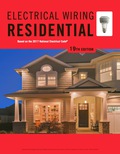
Electricity for the Trades
3rd Edition
ISBN: 9781260437386
Author: Petruzella, Frank
Publisher: MCGRAW-HILL HIGHER EDUCATION
expand_more
expand_more
format_list_bulleted
Concept explainers
Textbook Question
Chapter 1.2, Problem 9RQ
Compare what GFCIs and AFCIs protect against.
Expert Solution & Answer
Want to see the full answer?
Check out a sample textbook solution
Students have asked these similar questions
NO AI PLEASE
Describe how you would choose the input and output capacitors for a common source amplifier.
Whats the difference between an common-source and a common-drain amplifier (gain, input/output impedance)?
Chapter 1 Solutions
Electricity for the Trades
Ch. 1.1 - Does the severity of an electric shock increase or...Ch. 1.1 - In general, voltage levels above what value are...Ch. 1.1 - In general, current levels above what value are...Ch. 1.1 - What circuit fault can result in an arc flash?Ch. 1.1 - Define each of the following terms associated with...Ch. 1.1 - Explain why an arc flash is so potentially...Ch. 1.1 - What is a permit-required confined space?Ch. 1.1 - What does the term personal protective equipment...Ch. 1.1 - What personal protective attire is required when...Ch. 1.1 - When should face shields be worn?
Ch. 1.1 - A fall arrest system must be rigged so that...Ch. 1.1 - A ladder is used to reach the top of a building 16...Ch. 1.1 - What are the deck requirements for a scaffold work...Ch. 1.1 - Prob. 14RQCh. 1.1 - List the three ingredients required to sustain a...Ch. 1.1 - Which classes of fire are multipurpose...Ch. 1.1 - List four hazardous properties or characteristics.Ch. 1.2 - Prob. 1RQCh. 1.2 - Compare the terms grounding and bonding.Ch. 1.2 - Why is the earth not considered to be an effective...Ch. 1.2 - Explain what is meant by a ground fault.Ch. 1.2 - How does a ground-fault circuit interrupter (GFCI)...Ch. 1.2 - How does a ground-fault circuit interrupter (GFCI)...Ch. 1.2 - Explain what is meant by an arcing fault.Ch. 1.2 - Compare the amount of current that results from...Ch. 1.2 - Compare what GFCIs and AFCIs protect against.Ch. 1.2 - What does a lockout-tagout procedure refer to?Ch. 1.2 - Prob. 11RQCh. 1.2 - A voltmeter is used to verify that no voltage is...Ch. 1.2 - What is the main goal of OSHA?Ch. 1.2 - What is the primary purpose of the rules set forth...Ch. 1.2 - Assume a piece of electrical equipment has been...Ch. 1.2 - How often is the National Electrical Code updated...
Knowledge Booster
Learn more about
Need a deep-dive on the concept behind this application? Look no further. Learn more about this topic, electrical-engineering and related others by exploring similar questions and additional content below.Similar questions
- The line diagram is of a standard forward/reverse/stop pushbutton station for forwarding and reversing a motor. Included in the circuit are mechanical and auxiliary contact interlocking. Also included are a forward overtravel limit switch to stop the motor in forward and a reverse overtravel limit switch to stop the motor in reverse. Overload protection is common to both forward and reverse directions. Complete the wiring diagram based on the line diagram. Do not make any wire splices or additional terminal connections on the wiring diagram (notice how they make multiple connections in the power circuit). All connections must run from terminal screw to terminal screw complete the wiring diagram based on the line diagram. Do not make any wires splices or additional terminal connections on the wiring diagram. All connections must run from terminal screw to terminal screwarrow_forward6.7 Consider a baseband binary PAM system that transmits at 3600 bps with a bit error rate less than 10-4. The channel introduces no distortion, but attenuates the signal by 20 dB and has a bandwidth of 2.4 kHz. The channel noise is AWGN with a power spectral density of 10-14 watts per Hertz (W/Hz). Design the optimum transmitting and receiving filters, and determine the required transmit power.arrow_forward6.10 In a baseband digital transmission, the bandwidth is 4 kHz, and the bit rate must be at least 38.4 kbps. Assuming M-ary signaling, determine the range of acceptable values of M, and the resulting bit error rate.arrow_forward
- Assume a JFET device with VGS(0) = -1.3 and ipss = 20 mA. Design a self-biased (Fig. 2) JFET common-source amplifier with the gain of -2 and a DC biasing that allows the largest swing in ip. Note that you can choose Vcc to arrive at a desired RD to meet the gain requirement. Since you are designing for a given gain, you may have to check to see if JFET is biased correctly. (Hint: First find Rs for correct VGs and then use the gain to compute RD. Finally, use RD and Rs to determine Vec). Assume that the amplifier is to interface a source that expects a load of 50 2. Also, assume that the amplifier circuit is AC coupled at both ends with 3 dB corner frequency of 15 kHz.arrow_forwardEXAMPLE 6.7 Consider an M-ary system with the number of symbols M=16, and the roll-off factor a= Discuss this M-ary system, vis-à-vis the corresponding binary system, for various scenarios. Solution 1arrow_forwardDesign an oscillator circuit using the arrangement in Fig. 4 (namely, find C+1=C+2). Fig. 4 shows that we are using a pair of 2N5485 JFET. However, you are supplied with two J112 (or J113) to be used here. Use datasheet for J112 (or J113) to determine the needed capacitances. The oscillation frequency is considered to be 1 MHz. Use L₁ = L₂ = 112 μH. Furthermore, assume Cr=200 pF and Re = 300 . Is the assumption Cf >> CGS&CGD valid?arrow_forward
- 10pts: Matlab: From Problem 1 of homework 6, repeated below: Generate a random binary PAM transmit signal of -1 and + 1 volts of length 100. Simulate the transmit signal being sent over a channel with AWGN with an Eb/No of 3 dB. Plot the received signal constellation using a red o to represent when a logical 0 was sent and a blue * to represent a logical 1 was sent Question (1) Increase the Eb/No to 7 dB. Approximately what length of the signal do you need to get consistently within ~5% of the theoretical value for the bit error rate? a) Guess without doing any simulations b) Estimate by trial and observing the results.arrow_forward(1) A baseband PAM communication channel bandwidth is 100 KHz and has a noise power spectral density of 10^-9 W/Hz. The channel loss between the transmitter and receiver is 25dB. The application requires a bit rate of 500 Kbps and BER of less than 10^-5. The system uses raised cosine pulses with a roll-off factor of 0.25. Determine the minimum transmit power required. (2) Continuing problem 1. Everything for the previous problem stays the same BUT the best Power Amplifier you can afford has a maximum output power of 10 Watts. What will be estimated BER for the system?arrow_forwardExplain magnetic hysteresis and give examples of some calculationsarrow_forward
arrow_back_ios
SEE MORE QUESTIONS
arrow_forward_ios
Recommended textbooks for you
 EBK ELECTRICAL WIRING RESIDENTIALElectrical EngineeringISBN:9781337516549Author:SimmonsPublisher:CENGAGE LEARNING - CONSIGNMENT
EBK ELECTRICAL WIRING RESIDENTIALElectrical EngineeringISBN:9781337516549Author:SimmonsPublisher:CENGAGE LEARNING - CONSIGNMENT

EBK ELECTRICAL WIRING RESIDENTIAL
Electrical Engineering
ISBN:9781337516549
Author:Simmons
Publisher:CENGAGE LEARNING - CONSIGNMENT
FMPR-103 pt1 l Power Systems Protection v1; Author: L&D for Protection and Control;https://www.youtube.com/watch?v=ELWncjsh5uE;License: Standard Youtube License